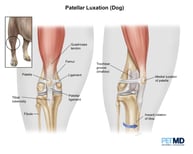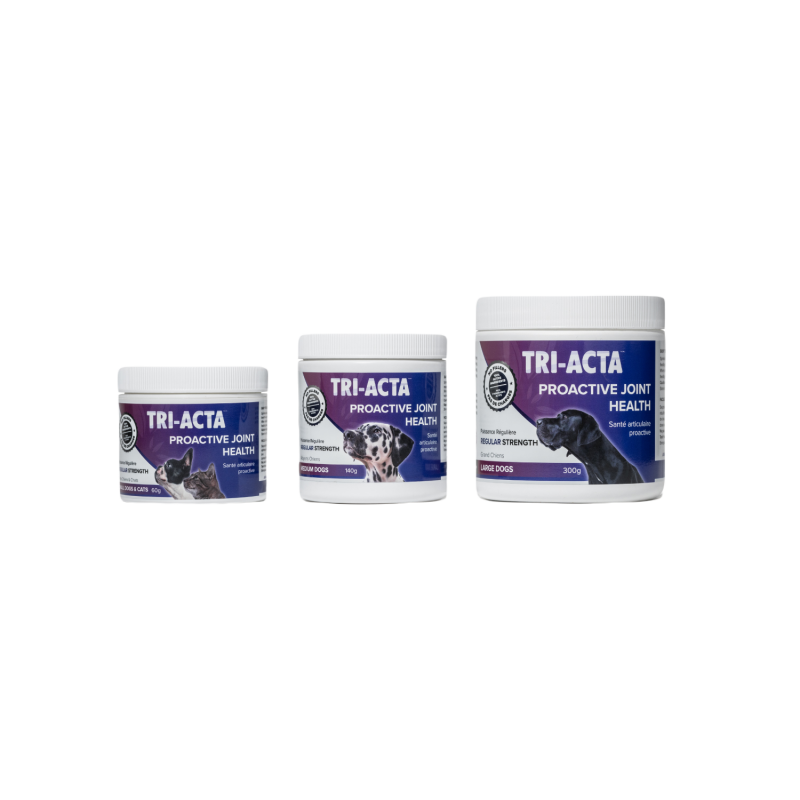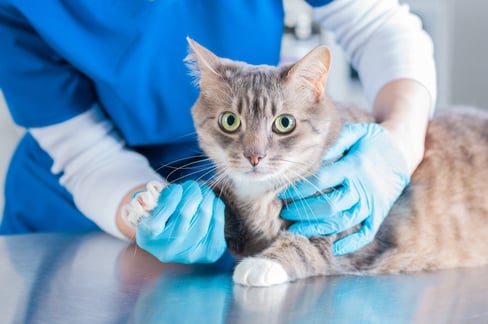Table of Contents
Have you noticed your dog hasn’t been acting normal? Maybe they aren’t walking quite right or are even avoiding walking altogether. Maybe their legs are tender, and their knees don’t appear quite right.
If that’s the case, it may be time to take a trip to the vet and ask about a medial luxating patella.
Although that might sound scary, there is no need to panic. Your dog will be fine, potentially even without surgery.
But, it’s important to know what you’re up against (especially if you have a small or toy breed more prone to luxating patellas). So, in this blog post, we’ll get into the ins and outs of medial luxating patellas in dogs as well as the different types, grades, diagnosis, treatment, and of course, some prevention tips, too.
What is Medial Luxating Patella in Dogs
A medial luxating patella is when a dog’s kneecap (or patella) shifts toward the dog’s body. Patellas can luxate in other ways, too (see below) but medially is the most common. The condition has various degrees of severity, measured in grades. No matter the severity, it’s a condition that can cause pain and discomfort in your pooch.
To really understand this condition, you must first understand the importance of the patella. Obviously, you already know it’s your dog’s kneecap. But, we’ve included a graphic of it below so you can see the context of it.

The patella is an incredibly important small bone at the front of your pup’s knee. It aids in all the movements your dog is making, like walking on a leash, running after balls, leaping for frisbees, and chasing their tail. If you’ve ever hurt your knee before, you understand how crucial it is to move and how difficult moving can be when it's injured.
There are two ways for your dog to get a medial luxating patella
- They're born with it
- Something happens to them
If your dog wasn’t born with this condition, it could get it through overuse of their legs (for instance, if they’re a working dog), injury, or being overweight.
Some signs that your dog has a luxating patella can be
- Limping or lameness
- Kneecap appears in the wrong spot
- Kneecap can move
Now that we know the basics of a luxating patella, let’s get into more details of the different types.
Types of Luxating Patella in Dogs
As we mentioned previously, there are different types of luxating patellas – three in total, including medial. The different types are defined by the direction that the patella shifts. We’ve outlined each type in the table below.
|
Type of Luxating Patella in Dogs |
Description |
|
Lateral Luxating Patella Dog |
When the patella shifts toward the outside of the leg, away from the body |
|
Medial Luxating Patella Dogs |
When the patella luxates inwards towards the body |
|
Bidirectional Luxating Patella Dog |
When the patella can shift in either direction |
Luxating Patella Grades

The severity of a luxated patella is measured in four grades, which are outlined in the table below.
|
Luxating Patella Grades in Dogs |
Description |
|
Grade 1 Luxating Patella |
The patella can be manually manipulated but returns to the right spot once the manipulation is done |
|
Grade 2 Luxating Patella |
The patella can be manually manipulated and will return to the right spot when manually returned |
|
Grade 3 Luxating Patella |
The patella has luxated, and it can be replaced with manual manipulation but may luxate again |
|
Grade 4 Luxating Patella |
The patella is luxated and cannot be replaced through manual manipulation |
In grade 1, your dog may not exhibit any symptoms of anything being wrong. The main symptom of a medially luxated patella in dogs is lameness, potentially with them moving in a slightly skipping gesture.
However, as you go through the grades, the severity of the luxation increases, and it becomes harder to treat.
Before your dog gets treatment, though, the luxating patella first must be found and diagnosed.
Medial Luxating Patella Diagnosis
If you suspect your pooch has a luxating patella (or something wrong with its legs in general), the first thing you’ll want to do is call your vet for an appointment. Your vet will be able to diagnose the issue, and a treatment plan can be created from there.
Physical Examination
A medial luxating patella in dogs can be found through a physical examination. Your vet will be able to feel that the kneecap has shifted. They may perform a sort of twisting motion, depending on the grade of the medially luxating patella in dogs to determine the damage or even shift the kneecap back. However, because this is such a delicate area, imaging can be used, too, to get a more conclusive diagnosis for your sweet pup.
Luxating Patella Dog X Ray and CT Scans
Medical imaging can also be used to assess any damage that’s been done to the hips or legs outside of the medial luxating patella in dogs or a lateral luxating patella in dogs. For instance, cartilage can be worn away over time. The erosion of cartilage can lead to arthritis, which can be a painful condition for your dog.
Another example is hip dysplasia, which can cause lateral luxating patellas in dogs. Hip dysplasia is a condition in dogs in which their hip joints don’t fit properly into their hips. It’s a more common issue in certain larger dog breeds, like German shepherds.
This type of imaging can also be used to find any other abnormalities in the shapes of the dog’s bones or internal structures to see any other issues that could be leading to the medially luxating patella in dogs.
Medial Luxating Patella Surgery
Depending on the severity (or grade) of your dog’s medial luxating patella, surgery may not be necessary. Instead, your dog will be able to get by with things like maintaining a healthy diet, adding joint supplements and undergoing physical therapy.
But, if your vet recommends it, you may want to consider surgery, even just to prevent the medial luxating patella in dogs from causing any further issues in the future.
If your dog does need surgery, there are several different types they may undergo (or need a combination of). The types of surgeries are divided into those that involve building up the soft tissue around the kneecap and those that include reshaping the bone.
As cited in the source above, some of the surgeries that involve reshaping bones include increasing the grooves of the cochlear, correcting the shape of the femur, and transposing the tibial crest.
Different surgeries will come with their own risks, but your vet should know which ones will be most effective for your pooch. If you have concerns about the procedure, you can speak about them with your vet before the surgery begins. Have them talk you through the process, so you understand what’s being done to your dog and why.
And make sure you ask them what to expect once your dog is home from surgery.
Looking After Your Pup Post-Surgery
So, your pup’s now had their surgery and is ready to come home. Before you bring them home, you’ll want to make sure you speak to your vet about whether or not your dog needs to come in so they can check the knee and, if so, when. Your dog may also have a bandage on that can be removed after a few days.
Once at home, you’ll want to let your pet rest with only light exercise for a month or two. Your vet can give you a more specific timeline, depending on the dog and the surgery. This rest is so your dog doesn’t ruin their stitches, but also to ensure they don’t re-injure their knees. Try to make sure your dog isn’t running around, playing rough, or doing strenuous exercise. Instead, you’ll want to limit them to activities like light walks, and even then, wait a few days until your dog is able to bear some weight onto their leg.
Monitor your dog’s stitches if you can, too, to ensure they aren’t getting an infection. Signs of infection could include the stitches becoming red, inflamed, irritated, or developing pus. If you observe this, make sure you bring your pup back to the vet for treatment. They’ll likely provide medication of some sort to fight the infection.
Your dog’s stitches are more likely to become infected if your dog licks, bites, scratches, or tries to connect with them in any way. This is why sometimes, after surgeries, dogs wear cones around their necks so they can’t get their mouth near their stitches.
If your dog has stitches, they’ll need to be removed, so you’ll be able to book the appointment with your vet when that occurs (likely a couple of weeks after the surgery).
You will also want to consider adding a joint supplement to help with the recovery post-surgery. TRI-ACTA H.A., for example, can help expedite the healing process and reduce the chances of developing post-traumatic arthritic symptoms in the future.
If your dog has been prescribed medication, ensure you are following the instructions on when to give your dog that medication, do your best to ensure your dog is taking it, and make sure your dog is taking it for the prescribed amount of time. Some dogs may struggle with taking pills, so if your dog has been prescribed pills, you may want to try different tips and tricks to make getting your dog to take them easier. Some things you can try include:
- Pill pockets
- Hiding the pill in your dog’s food
- Covering the pill in peanut butter
Medial Luxating Patella Prevention Tips

Even if you have a dog breed that’s prone to a medially luxating patella, like toy poodles or Yorkshire terriers, there are things you can do to help prevent it from happening. Typically, these things are just a part of keeping a healthy pup, so they’re good dog owner practice, even if you’re not worried about luxating patellas.
Allowing Your Dog to Have an Appropriate Amount of Exercise
It’s important to keep your pet healthy and strong, and it’s important to keep your pet active. But, you’ll want to make sure you’re giving your pooch the appropriate amount of exercise and letting them rest when they need it.
Part of helping prevent a medially luxating patella is keeping your pet at a healthy weight, so you do need to ensure you’re taking your pet for the appropriate walks, runs, etc. Different activity levels are appropriate for different dogs. High-energy breeds, like German shepherds, require more exercise than low-energy dogs, like basset hounds.
However, part of helping prevent a medial luxating patella is also making sure your dog’s not overworking their knees. So, make sure your dog is not overworking itself. Give them the proper rest they need to recuperate after they’ve worked hard.
It’s a delicate balancing act, but more likely than not, you’ll be able to follow your dog’s lead. They’ll show signs of fatigue when it’s time for them to come on inside and have a drink of water and a nap.
Give Your Dog a Healthy Diet
Making sure your dog has a healthy diet is twofold.
- It helps ensure your dog has all the nutrients they need to be healthy and strong, which will help prevent injury, like a luxating patella. This is because your dog’s diet will supply them with the proper vitamins, nutrients, and proteins to ensure your dog’s bones, joints, and muscles stay strong. Which will, in turn, help keep your dog’s kneecap in place.
- It helps ensure your dog stays at a healthy weight. If your dog is overweight, they will be putting more pressure and stress onto their joints, which could potentially make them more prone to injury in areas like the hips and legs, including the knees.
To ensure your dog is eating a healthy diet, you’ll want to feed them the best food for them. You may have to research what the right food for your dog is, including your dog’s specific needs and the ingredients in the dog’s food. (For instance, you’ll want to avoid foods with too many filler ingredients.)
We start your research for you with our blog post: Top 10 Best Canadian Natural Dog Food & Supplements.
If you’re still struggling to find the right food for your pup, don’t be afraid to reach out to your vet or other trusted pup health professionals for their recommendations.
Bolster Your Pooch’s Health with Supplements
Even if you feed your dog the best of the best food-wise, you may still miss certain health aspects. A great way to do that is with supplements.
Take 'hip and joint' food or 'mobility' kibble, for instance. The bags will often indicate around 1000mg of glucosamine in each bag. However, this is per kg of food. You would have to feed several kg's of food before having any actual therapeutic value. Plus, much of the efficacy of glucosamine for dogs is typically lost in the cooking and processing of the food.
If you're looking for a joint supplement to help prevent luxating patella or to treat mild to moderate joint conditions, check out our very own TRI-ACTA for pets.
It’s packed full of ingredients that target different aspects of joint health, including:s:
- Glucosamine: helps repair cartilage
- MSM: reduces pain and inflammation
- Chondroitin: aids in the prevention of the cartilage’s destruction
Dealing with a more severe case of luxating patella? For more advanced grades of this condition, TRI-ACTA H.A. for pets has all the same benefits as above, however it also contains a highly therapeutic form of hyaluronic acid, which helps lubricate the joints and keep your pup moving!
TRI-ACTA H.A. for Pets
Our maximum strength formula is optimally designed to accelerate the formation of cartilage, minimize inflammation, expedite the healing process, and improve joint conditions.

Take Your Dog to the Vet If Something’s Wrong
Our last tip is less about prevention and more to ensure the issues are caught as early as possible.
If something is wrong with your dog — take them to the vet for a checkup.
If you notice your dog limping, in pain, and can visually see or feel that something’s not quite right, a vet can help reverse the symptoms and decrease the chances for further deterioration. Once your vet completes a physical examination of your dog, they’ll be able to diagnose the issue, including if it’s a medial luxated patella.
Do not manipulate your dog's knee yourself unless you’ve been given specific instructions by your vet on how to do this.
Additional FAQ
How do you take care of your dog in the event of a medial luxated patella?
First, you must take them to a vet for a physical examination. Just because something is wrong with your dog’s legs doesn’t mean they have a medial luxated patella. You can learn about different types of things that could affect your dog’s legs in our post: Top 6 Dog Back Legs Weak and Shaking Treatment Options.
But, if you’ve taken your dog to the vet and they do have a medially luxating patella, then you can speak to your vet about treatment options.
How do you treat a medial luxating patella in dogs if it doesn’t require surgery?
If surgery isn’t necessary, you may want to consider creating a physical therapy schedule and adding the proper supplementation for mobility and joints. Glucosamine for dogs is an important mineral in the prevention and reduction of arthritis. Our very own TRI-ACTA H.A. for Pets contains two types of glucosamine to:
- Keep the cartilage healthy
- Help repair damaged cartilage
With grade 1 luxating patella, they may not have any symptoms yet, but prevention of further damage should be top of mind. TRI-ACTA for Pets is excellent for proactive measures.
TRI-ACTA for Pets
A proactive approach for developing and younger adult pets to maintain optimal joint health mobility, minimize inflammation and fend off age-related ailments.

You’ll also want to make sure you’re keeping your dog at a healthy weight. If your dog is overweight, they’ll put extra pressure on their joints, including their kneecap. Make a plan to help them lose weight:
- Walking your dog more (although, be careful of their injured knee)
- Changing their food to something targeted towards losing weight
- Feeding your dog less food at mealtimes as per vet recommendations
- Feeding your dog fewer treats and snacks outside of mealtimes
Final Takeaways
The patella is a delicate but important part of your dog’s leg for movement. So if you suspect you’re experiencing a medial luxating patella in dogs, take them to the vet for the proper diagnosis. From there, a treatment plan can be created, although in general, if caught early enough, the prognosis should be good. Some minor cases don’t even require surgery.
That being said, you don’t want your dog to develop a medially luxating patella. So, there are things you can do to help ensure it doesn’t happen like
- Exercise your dog the appropriate amount
- Feed your dog a healthy diet
- Bolster your pet’s diet with supplements
- Take your pooch to the vet if something’s wrong
To begin on our prevention tips now, shop for our joint supplements for pets here.
Or, to learn more about the health of your dog and how to look after it, check out our pet blog posts or resources page.
And, if you have any questions, don’t hesitate to contact us.
Newsletter Signup
Subscribe to our newsletter to receive the latest news and exclusive offers.
.jpg?height=2000&name=Cliick_Integricare-DISPLAY-REVISEDV2%20(1).jpg)
Proactive & Therapeutic Joint Supplements
When given daily, Integricare joint supplements recover bone and joint injuries faster and help prevent mobility injuries from happening in the first place.











